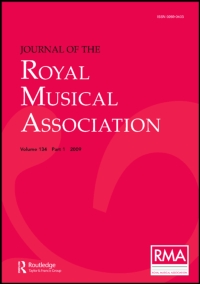Article contents
The Apprehension and Cognition of Music
Published online by Cambridge University Press: 01 January 2020
Extract
When we listen to a piece of music, whether it be a fugue by Bach, a song by Schubert, or a symphony by Beethoven, the actual physical, objective, stimuli which reach our ears consist of incredibly complicated pulsations of air pressure. These produce equally complicated vibrations of the tympanum or ear-drum, and so set up successions of nervous impulses in the brain. But our subjective experience of the music, the thing that we actually hear, consists of a logical and meaningful sequence of harmoniously interrelated auditory impressions, possessing form and unity both as a whole and in detail. How then does this series of discrete air vibrations, which are produced by the musical instruments or voices of the performers, become transformed and organised into the mental thing that we call music? In other words, what is the psychological nature of our perception or cognition of music?
- Type
- Research Article
- Information
- Copyright
- Copyright © Royal Musical Association, 1932
References
1 Music and Its Lovers. London: Allen & Unwin, 1932.Google Scholar
- 1
- Cited by


